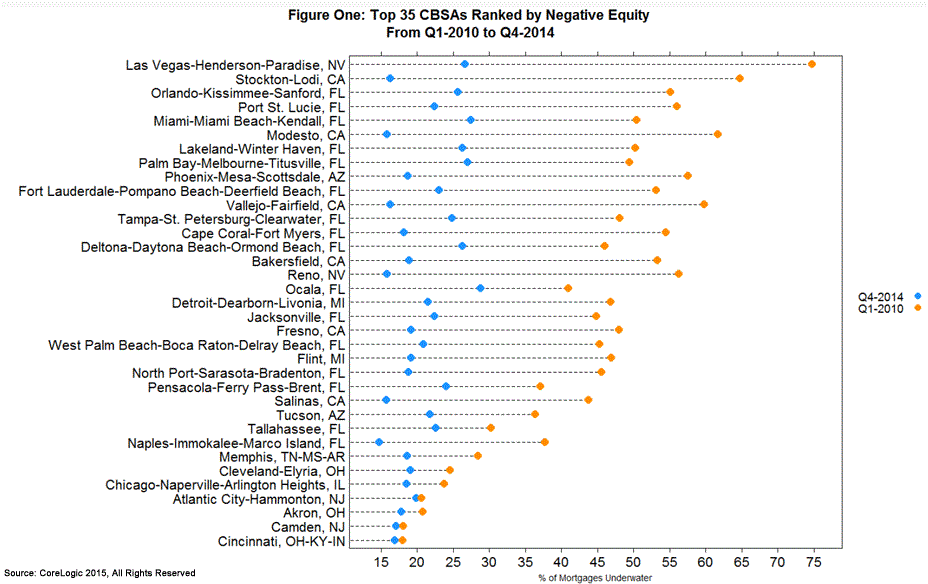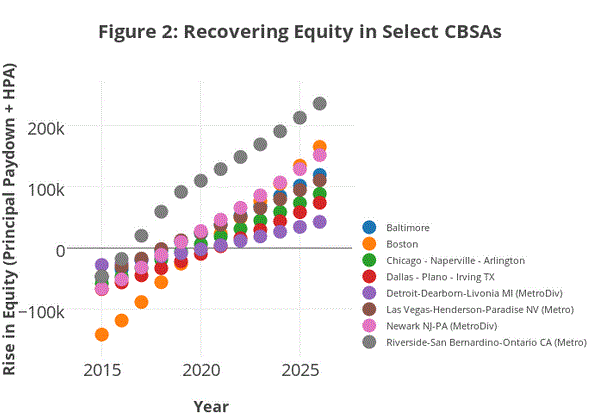Blog

Viable Principal Reduction Plan Would Likely Have Limitations -CoreLogic
Among the mostrncontentious issues at the Federal Housing Finance Agency (FHFA) when Edward J. DeMarcornwas its acting director was his refusal to allow Fannie Mae and Freddie Mac (thernGSEs) to adopt a principal reduction (or PR) program, citing FHFA’s duty as theirrnconservator to protect their assets. Hisrnopposition continued even as the Treasury Department offered incentives tornlenders through the Home Affordable Modification Program (HAMP) it co-sponsorsrnwith FHFA. This provoked considerablernfriction between the acting director and many members of Congress. </p
After he wasrnreplaced by Melvin L. Watt as permanent director in January 2014, principalrnreduction fell out of the news. Housingrnadvocates expected Watt to reverse DeMarco’s policy, permitting Fannie Mae andrnFreddie Mac to employ PR as part of their loan modification packages but he hasrnnot yet done so. </p
With PR a portion ofrnthe outstanding mortgage balance (which has often been inflated by legal costs,rnlate fees, and other penalties during the delinquency) is reduced to morernaccurately reflect the current market value of a home with negative equity Inrnaddition to creating an incentive to homeowners to make mortgage payments – a homernthat is underwater is more likely to become delinquent or redefault afterrnmodification – a reduced balance is an additional tool to enable lower monthlyrnpayments.</p
Even as the numberrnof foreclosures has receded and millions of homes have returned to positivernequity pressure has continued to initiate a principal reduction (or PR) programrnfor GSE owned or guaranteed loans and in February Watt said that the issue wasrnstill being studied by his agency. Herntold reporters that if PR were implemented it would be a narrower program thanrnadvocates have called for because he was also concerned for the GSEs’rnfinances. </p
How might a “narrower”rnPR program work? In an article in CoreLogic’srnInsites blog company policy research andrnstrategy analyst, Stuart Quinn, said that FHFA’s ongoing assessment of anyrnimplementation “likely hinges of a few key questions” and expands on a 2012rnspeech given by DeMarco at the Brookings Institute. The considerations include the differencernbetween principal forgiveness and principal forbearance which was DeMarco’srnendorsed approach. Other factors in therndecision could be the future of home prices and FHFA’s general mission.</p
Quinn says thatrnproperties that continue to remain underwater not only maintain higher levelsrnof default risk but also reduce the properties available for purchase (asrnunderwater borrowers usually must go through the short sale process). Quinn speculates that if and when FHFA adoptsrna new policy “it will likely be targeted and may solely expand utilization ofrnprincipal deferral as an option.”</p
The article, “A Closer Look at Equity,rnPrinciples of Principal Reduction,” putsrnthe GSE’s rate of seriously delinquent loans (SDQs) at the end of 2014 at 1.89rnfor Fannie Mae and 1.88 for Freddie Mac, close to their rates in September 2008rnwhen the two were placed in conservatorship but substantially lower than at thernpeak. In more normal times the two ran rates of about 0.5 percent. </p
The GSE’s SDQ figures include loans inrnforeclosure and for Freddie Mac approximately 53, 61, and 68 percentrnrespectively of its SDQ’s were in foreclosure proceedings at the end of 2014,rn2013 and 2012 respectively. Loans inrnforeclosure are unlikely to qualify for principal reduction due to their stagernof distress, Quinn says, so, while the stage and requirements for eligibilityrnwould have to be determined by FHFA, the remaining population of eligible loansrncould be relatively small. He projects arnconservative estimate of just under 265,000 loans across both GSEs but saysrnthat given the concentration of numbers in judicial states with lengthyrnforeclosure timelines his figure may still be too high. He also assumes that a net-present-valuernanalysis would likely also be conducted on a loan-by-loan basis to determinerneligibility.</p
 </p
</p
Quinn looked at rates of homes inrnnegative equity at two points of time – the first quarter of 2010 and the endrnof 2014 – in 35 Core Based Statistical Areas (CBSAs). Many of the cities with the most severernproblems at the earlier point had also shown the greatest improvement overrntime. For example, in the Las Vegas arearnthree out of four properties were worth less than their outstanding mortgagernbalance in 2010, but that rate was down by 50 percentage points four yearsrnlater. Some of the worse CBSAs inrnCalifornia such as Stockton, Modesto, and Fresno have made “remarkablernrecoveries” with negative numbers declining by one-third to one-half. In the Midwest however many of those CBSAs hardestrnhit have not shown nearly that much progress. rnOverall, every one of the 35 most underwater areas in 2010 continues tornhave elevated figures – a minimum of three out of 20 homes. </p
Quinn says that any policy of principalrnreduction coming from FHFA “will likely need to validate that it is targeting jurisdictionsrnand individuals whose hardships are commensurate with the downturn, rather thanrnreinforcing local policy decisions that could inhibit the rate of recovery.” Herncites The Neighborhood Stabilization Initiative (NSI) under FHFA that targetsrnthe City of Detroit and Cook County, Illinois and reinforces the approach ofrntargeting slower recovering areas whose current home prices may not regain thernmarket values reached during their peaks anytime soon. </p
To see how long it might take anrnaverage underwater home to reach positive equity without intervention Quinn testedrna few key CBSAs using CoreLogic’s Home Price Index (HPI) five-year forecast andrnamortized mortgage payments assuming a mortgage coupon of 5.22 percent. The analysis acknowledges that it will take areasrnwith higher rates of negative equity longer to normalize than areas with smallrnnumbers. </p
 </p
</p
Quinn says his analysis indicates that inrnmost of the areas it will take nearly five to six years for the averagernunderwater property to right side itself and while there is variation among thernareas, most receive a larger contribution to rising equity from market recoveryrnthan from principal pay down. “Forrninstance, in the first few years, Riverside, California’s home price appreciationrncontribution appears that it will outpace the scheduled principal payment,rnwhile the opposite is true in the Baltimore area.”</p
He concludes that the sensitivities andrndiversity of stakeholders that will be impacted by principal reduction makesrnthe policy decision particularly difficult to weigh and determine. “Thernramifications of strategic defaults, operational costs of implementing thernprogram, incentive offsets within the principal reduction alternative programrnunder Treasury and net-present-value calculations will all play a role inrndetermining whether a change in policy makes sense. As the decision continuesrnto remain under review, housing market appreciation and scheduled pay-down willrncontinue to chip away at the 5.4 million existing homes in negative equity thatrncontinue to remain off-market, with the largest proportion of those homesrnresiding in the lower value house price tier.”
All Content Copyright © 2003 – 2009 Brown House Media, Inc. All Rights Reserved.nReproduction in any form without permission of MortgageNewsDaily.com is prohibited.
Latest Articles
By John Gittelsohn August 24, 2020, 4:00 AM PDT Some of the largest real estate investors are walking away from Read More...
Late-Stage Delinquencies are SurgingAug 21 2020, 11:59AM Like the report from Black Knight earlier today, the second quarter National Delinquency Survey from the Read More...
Published by the Federal Reserve Bank of San FranciscoIt was recently published by the Federal Reserve Bank of San Francisco, which is about as official as you can Read More...

Comments
Leave a Comment